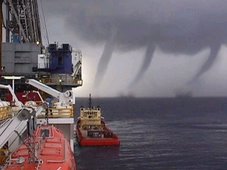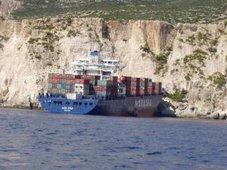 Global Sea-Rise Levels By 2100 May Be Lower Than Some Predict
Global Sea-Rise Levels By 2100 May Be Lower Than Some PredictDespite projections by some scientists of global seas rising by 20 feet or more by the end of this century as a result of warming, a new University of Colorado at Boulder study concludes that global sea rise of much more than 6 feet is a near physical impossibility.
Tad Pfeffer, a fellow of CU-Boulder's Institute of Arctic and Alpine Research and his colleagues made calculations using conservative, medium and extreme glaciological assumptions for sea rise expected from Greenland, Antarctica and the world's smaller glaciers and ice caps -- the three primary contributors to sea rise. The team concluded the most plausible scenario, when factoring in thermal expansion due to warming waters, will lead to a total sea level rise of roughly 3 to 6 feet by 2100.
A paper on the subject was published in the Sept. 5 issue of Science. Co-authors of the study were of the University of Montana's Joel Harper and Shad O'Neel of the Scripps Institute of Oceanography at the University of California, San Diego. The study was funded by the National Science Foundation and a University of Colorado Faculty Fellowship.
"We consider glaciological conditions required for large sea level rise to occur by 2100 and conclude increases of 2 meters are physically untenable," the team wrote in Science. "We find that a total sea level rise of about 2 meters by 2100 could occur under physically possible glaciological conditions but only if all variables are quickly accelerated to extremely high limits."
"The gist of the study is that very simple, physical considerations show that some of the very large predictions of sea level rise are unlikely, because there is simply no way to move the ice or the water into the ocean that fast," said Pfeffer.
The team began the study by postulating future sea level rise at about 2 meters by 2100 produced only by Greenland, said Pfeffer. Since rapid, unstable ice discharge into the ocean is restricted to Greenland glacier beds based below sea level, they identified and mapped all of the so-called outlet glacier "gates" on Greenland's perimeter -- bedrock bottlenecks most tightly constraining ice and water discharge.
"For Greenland alone to raise sea level by two meters by 2100, all of the outlet glaciers involved would need to move more than three times faster than the fastest outlet glaciers ever observed, or more than 70 times faster than they presently move," said Pfeffer. "And they would have to start moving that fast today, not 10 years from now. It is a simple argument with no fancy physics."
In Antarctica, the majority of ice entering the ocean comes from the Antarctic Peninsula and the Pine Island and Thwaites glaciers, said Pfeffer. Most of the marine-based ice in West Antarctica is held behind the Ross and Filcher-Ronne ice shelves, which Pfeffer's team believes are unlikely to be removed by climate or oceanographic processes during the next century. The researchers used varying glacier velocities to calculate sea-rise contribution estimates from the Antarctic Peninsula, Pine Island and Thwaites glaciers.
The team also used assessments of the world's small glacier and ice cap contributions to sea level rise calculated by a CU-Boulder team and published in Science in July 2007. That study indicated small glaciers and ice caps contribute about 60 percent of the world's ice to oceans at present, a percentage that is accelerating.
Considering all major sources of sea level rise, including Greenland, Antarctica, smaller glaciers and ice caps and the thermal expansion of water, the team's most likely estimate of roughly 3 to 6 feet by 2100 is still potentially devastating to huge areas of the world in low-lying coastal areas, said Pfeffer.
Some scientists have theorized that continuing warming trends in Greenland and Antarctica could warm the Earth by 4 degrees F over the present by 2100. The last time that happened, roughly 125,000 years ago during the last interglacial period, glacier changes raised sea level by 12 to 20 feet or more. But the time scale is poorly constrained and may have required millennia, Pfeffer said.
"In my opinion, some of the research out there calling for 20 or 30 feet of sea rise by the end of the century is not backed up by solid glaciological evidence," said Pfeffer.
Policymakers need to be able to predict sea level accurately if communities, cities and countries around the world are going to be able to plan effectively, Pfeffer said. "If we plan for 6 feet and only get 2 feet, for example, or visa versa, we could spend billions of dollars of resources solving the wrong problems."
Note: This story has been adapted from a news release issued by the University of Colorado at Boulder
IKE TRACK
|
Emergency personnel offer advice on preparing for disasters
Barrow County Fire and Emergency Services have joined with the Department of Homeland Security in marking September as National Preparedness Month.
If every family in Barrow County looks at becoming better prepared, the damages and loss of life from a disaster can be reduced, according to local officials.
“Being prepared is very important in a disaster no matter how big or small,” said Lt. Scott Dakin, public information officer. “The better prepared a citizen is the more they increase their chances of surviving a disaster. It also will help in recovering from such an event.”
One way that Barrow County Fire and Emergency Services prepares for disasters is by participating with the Barrow County Emergency Management Agency (EMA).
There are two personnel that serve as officers with the EMA. Assistant chief Mark Melvin is the deputy director and Lt. Ernest Weant is the operations officer. Both personnel have taken extensive training to become certified emergency managers.
The Barrow County Emergency Management Agency is a local organization that serves to prepare and assist in the protection of life and property in the event of a natural or man made disaster. This is accomplished through the process of preparedness, response, recovery and mitigation.
Another group that the department participates in is the Barrow County Citizens Corp Council.
Assistant chief Mark Melvin serves as the head of the council, and Lt. Ernest Weant and Lt. Scott Dakin also serve on the council.
The Citizen Corps Council works with the EMA and other public safety departments to establish volunteers to assist with disaster mitigation. One of the volunteer organizations that falls under the Citizens Corp is the Community Emergency Response Team (CERT).
CERT is a group of trained volunteers that can assist in different ways to mitigate disasters and other ways to assist public safety. The current CERT classes will have seven different personnel from fire and emergency Services participating as instructors for the class.
One type of natural disaster that citizens of Barrow County need to prepare for is tornados. Jackson and Hall counties were recently hit by tornadoes from the effects of Tropical Storm Faye. With this in mind, it is important for citizens to be prepared and alert for tornadoes. It is also important to know the terms used by the Weather Service.
When Barrow County is under a tornado watch it means that tornadoes are possible. Citizens should watch the sky for approaching storms and monitor the radio or television for updates.
When a tornado warning is issued, it means that a tornado has been spotted or is indicated by weather radar. If Barrow County goes under a tornado warning, citizens should immediately seek shelter. It is important to have a plan in place before a tornado warning is issued.
Every family in Barrow County should have a disaster plan that includes what to do in the event of a tornado or tornado warning.
This tornado plan should include where to go for shelter in a building or if caught outside. As part of your plan, you should also include what family members should do after a tornado has occurred. You should answer questions such as how to contact each other if family members become separated, where you would stay if your home is damaged by a tornado, and many other questions.
“A family disaster plan will help in reducing the damage and stress that a disaster can place on your family,” Dakin said. “It is much better to be prepared before a disaster occurs, than to try to determine what to do when a disaster occurs.”
For more information on developing your family’s disaster plan, visit the Federal Emergency Management Agency at www.fema.gov or www.ready.gov for information about planning from the Department of Homeland Security.
RS


































































































![Validate my RSS feed [Valid RSS]](valid-rss.png)